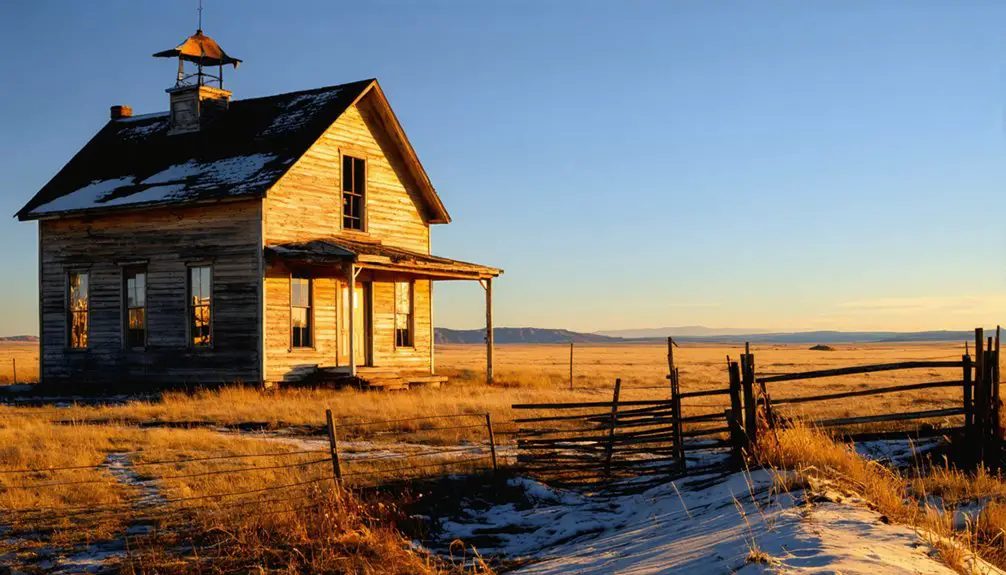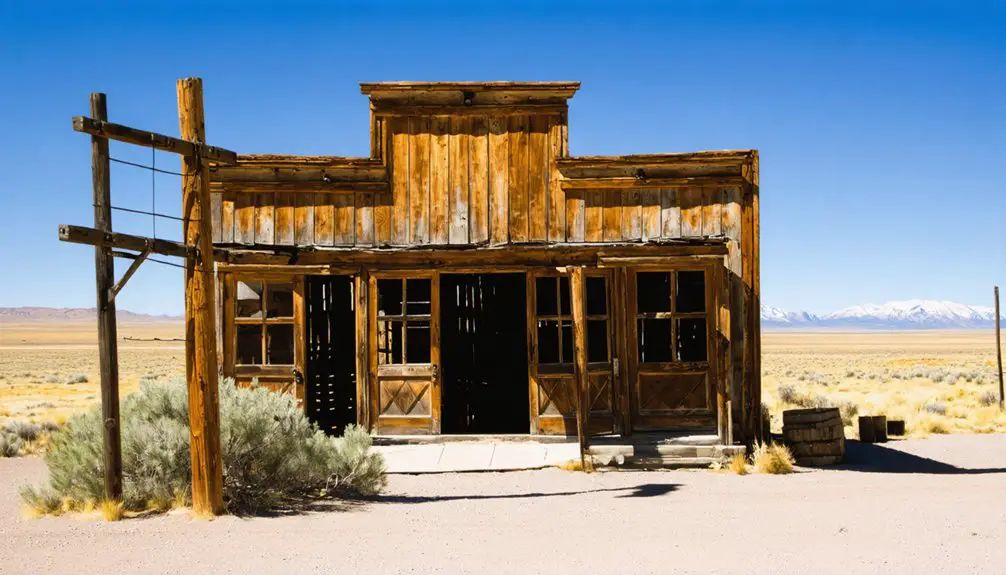You’ll find Jireh’s ghostly remains east of Keeline along U.S. 20, though nothing visible marks this once-thriving Christian college town. Founded by Reverend George Dalzell in 1910, Jireh College operated for twelve years as both an educational and spiritual hub, with students working the experimental farm while pursuing their studies. Despite its short life, this innovative frontier community left an enduring mark on Wyoming’s educational and agricultural heritage, with stories that stretch far beyond its vanished structures.
Key Takeaways
- Jireh was founded by Reverend George Dalzell in early 20th century Wyoming, starting as a college town with four students in 1910.
- The town has completely vanished from the landscape, with no remaining structures or markers of the college or Prairie View Church.
- Visitors can find the ghost town’s location east of Keeline along U.S. 20, though nothing physical remains of the settlement.
- The community thrived through agricultural education and dry farming experiments before its eventual abandonment after twelve years.
- Jireh’s legacy lives on through historical records and place names, despite the complete disappearance of its physical structures.
A Vision of Christian Education on the Prairie
When frontier families sought both spiritual and academic growth for their children in early 20th century Wyoming, Jireh College emerged as a beacon of hope. Founded by Reverend George Dalzell, this unique institution’s mission impact extended far beyond traditional education, offering both high school and college courses to youth from remote ranches and farms.
You’ll find that Jireh’s educational outreach was deliberately designed to be accessible, keeping costs reasonable for frontier families while delivering Christian education to communities lacking religious privileges. For just sixty-five dollars annually, students could receive a quality education that included both secondary and collegiate coursework. Beginning with four students in its first term on July 18, 1910, the college demonstrated its commitment to educational excellence despite its humble start.
As a messenger of Christ’s teachings, the college created a distinct environment where faith and learning intersected daily. The institution served as both an educational hub and spiritual center, transforming a sparse prairie region into a thriving Christian agricultural colony under the guidance of the Christian Church of Dayton, Ohio.
The Birth and Planning of a Frontier Town
As Reverend George Dalzell homesteaded land west of John Breese Day’s property in 1908, the vision for Jireh began taking shape as a Christian college town along Wyoming’s Highway 20.
The land acquisition moved swiftly when Jessie A. Dalzell and R.G. Coffin transferred the deeded property to the newly formed Jireh Land Company in 1909.
Town planning commenced immediately with twenty acres designated for the college campus. You’d have found essential services springing up across the settlement: two banks, a lumber yard, a post office, store, and express office. Like the short-lived boom towns that dotted Wyoming’s landscape during mining rushes, Jireh’s development happened rapidly.
The community’s dedication showed in their construction of the Prairie View Church, hauling lumber from 60 miles away. Five different denominations worked together, demonstrating the frontier spirit that would define Jireh’s early development. The vital stop served countless pioneers traversing the Wyoming territory.
Faith and Learning: The College Years
You’ll find that Jireh College’s unique blend of faith and academics manifested in its daily campus operations, where students participated in both traditional studies and hands-on agricultural work at the experimental farm.
The college’s Christian foundation, established by Reverend George Dalzell, shaped its educational philosophy through Scripture-based teachings and practical life skills.
The institution’s commitment to holistic education was evident in how students balanced their academic pursuits with farming activities near the Cheyenne River, growing everything from sugar beets to sunflowers while developing their spiritual lives through the Prairie View Church.
Campus Life and Education
Through extensive research of campus life across American universities, clear patterns emerge showing how modern institutions foster student success and satisfaction.
You’ll find today’s campus culture emphasizes student engagement through diverse housing options, social events, and robust academic support systems. Data reveals the most successful schools maintain retention rates above 90% by creating environments where you feel valued and welcome. Leading institutions like the University of Michigan maintain high acceptance standards with an 18% admission rate. Research shows quality relationships are crucial for overall student happiness.
- Housing diversity promotes cultural exchange and eases your adjustment to college life
- Strong extracurricular programs help you build lasting peer connections
- Responsive support services guarantee you stay on track academically while maintaining well-being
These elements create vibrant campus communities where you’re likely to thrive, as evidenced by high graduation rates and post-college success measures at leading institutions across America.
Christian Mission and Teaching
Christian colleges and universities in America serve a distinct purpose by integrating biblical truth with academic excellence across all aspects of higher education. At Jireh College, this mission integration was evident in how faculty wove scripture and faith development into every academic discipline, from science to literature.
You’ll find that these institutions focused on developing the whole person – mind, spirit, body, and emotions – rather than just delivering information. The approach proved remarkably successful, with Christian college graduates showing strong faith commitments despite higher education levels. This commitment to holistic development helped create anchors of activity in their local communities. Faculty demonstrated exceptional adaptability by shifting to online instruction during challenging times while maintaining their commitment to faith integration.
Through intentional programming and mentorship, students learned to connect their academic studies with biblical truth while preparing for lives of service. This holistic education model helped establish Jireh College’s reputation for producing graduates who could effectively integrate their faith with their professional calling.
Agricultural Life and Community Bonds
You’ll find that Jireh College students played an essential role in the community’s agricultural success, working the fields as part of their education while learning innovative dry-farming techniques.
The town’s settlers established an informal crop-sharing system, where farmers would help neighboring homesteads during planting and harvest seasons, strengthening their communal bonds through agricultural cooperation. The local Keeline Lumber Co. supported development by providing building materials for barns and storage facilities.
Despite the region’s semi-arid conditions, farmers near the Cheyenne River experienced better yields, particularly with drought-resistant crops like wheat and sugar beets. The Christian Church founders from Ohio established strict moral guidelines that shaped the community’s work ethic and cooperative spirit.
Farming Through Student Labor
While Jireh College operated between 1909 and 1920, its unique educational model combined traditional liberal arts with hands-on agricultural training that proved essential to Wyoming’s frontier development.
You’d find students actively participating in dry farming experiments, growing wheat, sugar beets, and potatoes without irrigation in the semi-arid conditions.
The college’s practical approach to farming education emphasized:
- Student labor that sustained both college operations and community farming needs
- Hands-on training in agricultural practices specific to Wyoming’s challenging climate
- Youth engagement through direct involvement in planting, tending, and harvesting crops
This labor-centered education helped integrate young people into the agricultural community while reinforcing Christian values of service and industry.
The system aimed to create lasting bonds between students and their frontier home, providing them with practical skills for local opportunities.
Community Crop Sharing Efforts
Building on the student labor system, Jireh’s agricultural community developed a remarkable crop sharing network that strengthened local bonds and improved farming outcomes.
You’ll find that local farmers routinely rented plots on the experimental farm, creating an interconnected web of agricultural cooperation. Through communal harvesting efforts, farmers and college students worked side-by-side, sharing both the labor and the fruits of their toil.
The community’s approach to crop rotation benefited from this collaborative spirit, as farmers freely exchanged knowledge about successful dry farming techniques.
When you examine the partnerships between the Jireh Land Company and local agriculturalists, you’ll see how their nonprofit structure encouraged shared resource management and collective problem-solving, especially during challenging growing seasons.
Cheyenne River Growing Success
Nestled along the meandering Cheyenne River, the 4W Ranch established by JW Hammond in 1879 became a cornerstone of Wyoming’s agricultural evolution.
Through six generations of the Harshbarger family’s stewardship since 1924, the ranch exemplifies cattle ranching excellence and community resilience.
You’ll find innovative grazing management practices that have sustained the ranch’s success:
- Rotational grazing systems that preserve rangeland health
- No-till drilling techniques for soil stabilization
- Strategic sagebrush treatments supporting wildlife conservation
The ranch’s commitment to agricultural sustainability shows in its balanced approach to livestock productivity and environmental preservation.
With the Cheyenne River’s six-mile stretch across the property supporting hay meadows and pastureland, the 4W Ranch continues to thrive through scientific range management and strong community bonds.
Traces of Yesterday: What Remains Today
Unlike many historic ghost towns across Wyoming that still showcase weathered buildings and crumbling foundations, Jireh has vanished entirely from the landscape.
Wyoming’s ghost towns often leave behind visible traces of the past, but Jireh stands apart – completely erased from the land it once occupied.
You’ll find no trace of the denominational college that once stood proudly from 1909-1920, nor any remnants of the Prairie View Church that served the faithful settlers of this dry-farming community.
The ghost town’s historical significance lives on primarily through place names like Jireh Road and in documented records.
While you can access the location east of Keeline along U.S. 20, don’t expect to see any physical structures or interpretive markers.
The surrounding agricultural landscape continues to reflect the area’s farming heritage, but the buildings, including those of the “Dieleman Neighborhood,” have completely disappeared into time.
The Legacy of Wyoming’s Educational Ghost Town

Founded in 1908 by Reverend George Dalzell, Jireh College represented a pioneering vision for Christian education on Wyoming’s frontier, where academic pursuits merged with practical agricultural training.
While the educational experiment lasted only twelve years, it left an enduring legacy of frontier innovation.
You’ll find Jireh’s impact reflected in these pioneering achievements:
- Combined advanced academics with hands-on farming, offering students a unique $65 tuition that included room and board
- Established an experimental dry farm that served both educational purposes and supported the local farming community
- Attracted distinguished faculty like Dr. Adkinson from the University of Chicago, bringing world-class education to Wyoming’s prairie
Despite facing harsh frontier challenges that ultimately led to its closure by 1920, Jireh stands as a symbol of Wyoming’s bold educational ambitions.
Frequently Asked Questions
What Was the Highest Student Enrollment at Jireh College?
You’ll find that Jireh College’s student demographics peaked at around 100 students, though historical records indicate actual enrollment likely fluctuated between 50-100 before the institution’s closure in 1920.
How Many Families Lived in Jireh During Its Peak Population?
Imagine a frontier town where each homestead housed hardworking farmers. While the total population reached 100 around 1921, you can’t know the exact family demographics since records don’t specify household numbers during peak population growth.
What Happened to the College’s Faculty After the Town’s Decline?
You’ll find that faculty relocation followed predictable paths – most professors sought positions at other colleges or religious institutions, though their exact movements and legacy impact aren’t well documented in historical records.
Were There Any Notable Graduates From Jireh College?
You won’t find any notable alumni from Jireh College’s brief history. The school’s records don’t show any graduates who gained widespread recognition during its short operation from 1909 to 1920.
Did Any Businesses Besides Farming and Education Exist in Jireh?
You’ll find a bustling local commerce scene with general stores, banks, hotels, blacksmith shops, lumber yards, and a newspaper. The town had everything except mining operations in its business district.
References
- http://genealogytrails.com/wyo/niobrara/history_jireh.html
- https://sites.rootsweb.com/~wytttp/ghosttowns.htm
- https://www.youtube.com/watch?v=ErvYfYCW0qk
- http://www.wyomingtalesandtrails.com/jireh.html
- https://travelwyoming.com/blog/stories/post/5-wyoming-ghost-towns-you-need-to-explore/
- https://www.hmdb.org/m.asp?m=98302
- https://archiveswest.orbiscascade.org/ark:80444/xv361620
- https://wyomingdigitalcollections.ptfs.com/aw-server/rest/product/purl/WSL/i/174ff535-26e7-40b4-9120-9aa1ec521135
- https://evendo.com/locations/wyoming/weston-county/landmark/jireh-historical-site
- https://www.niche.com/colleges/search/best-student-life/



